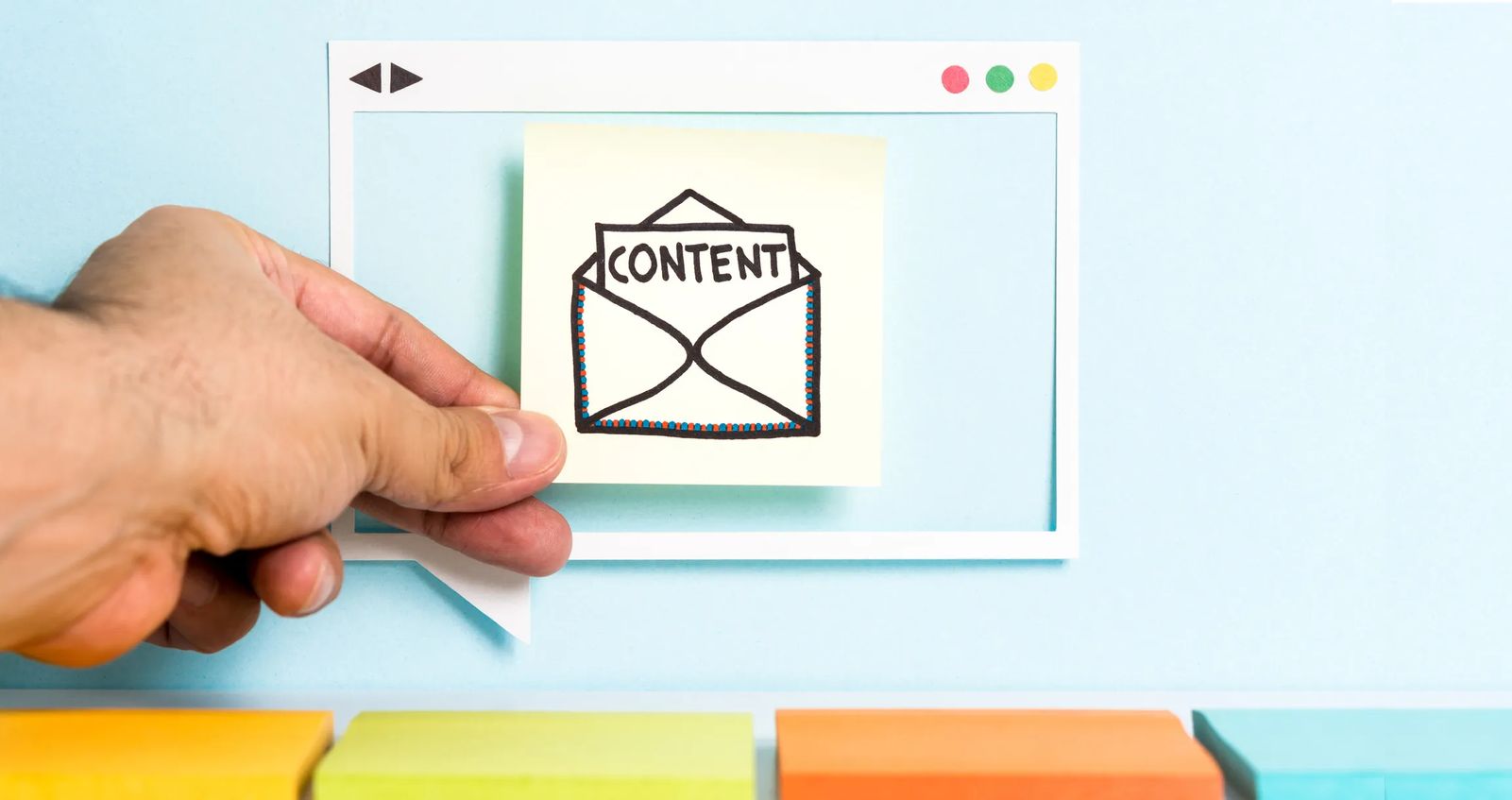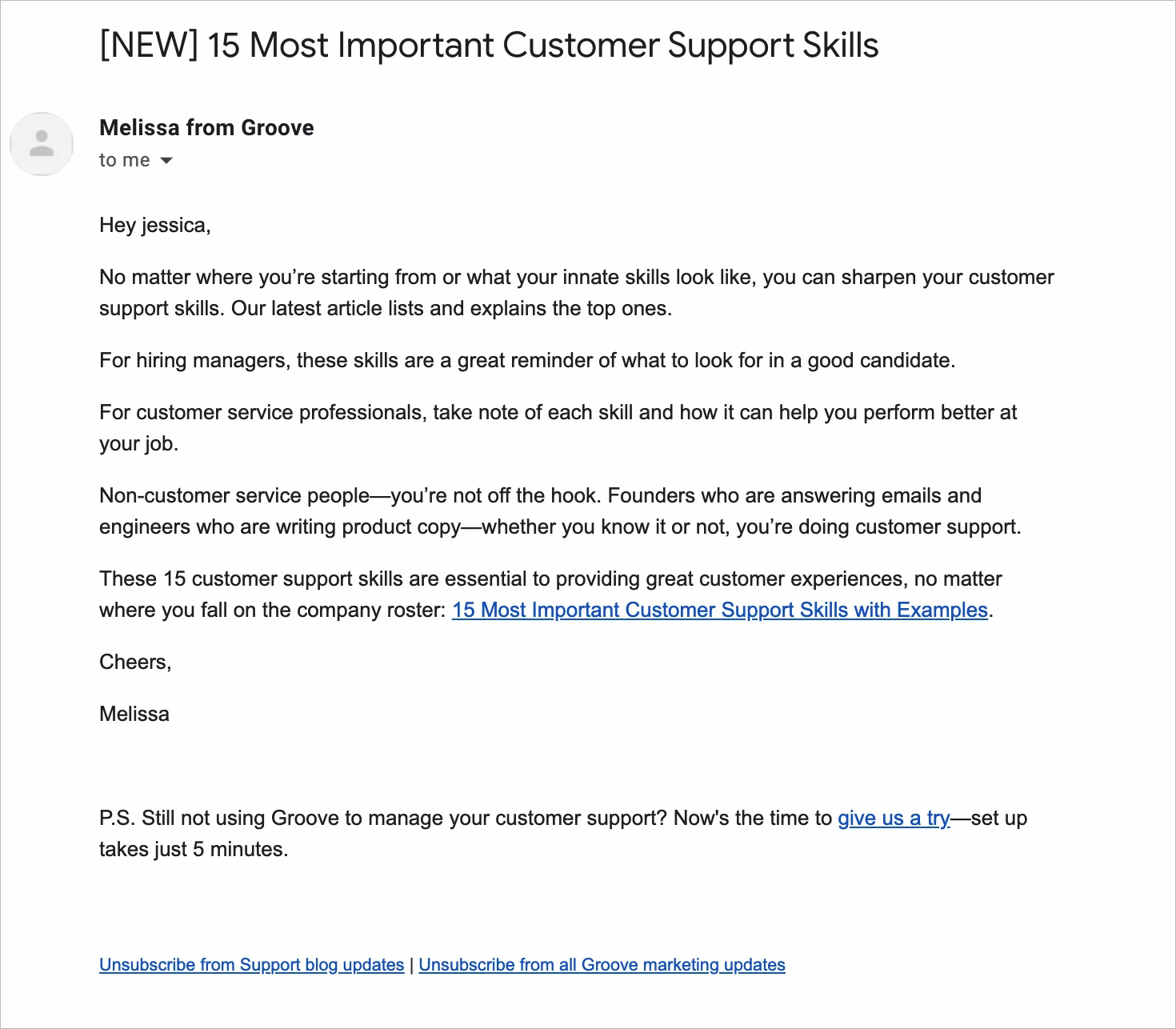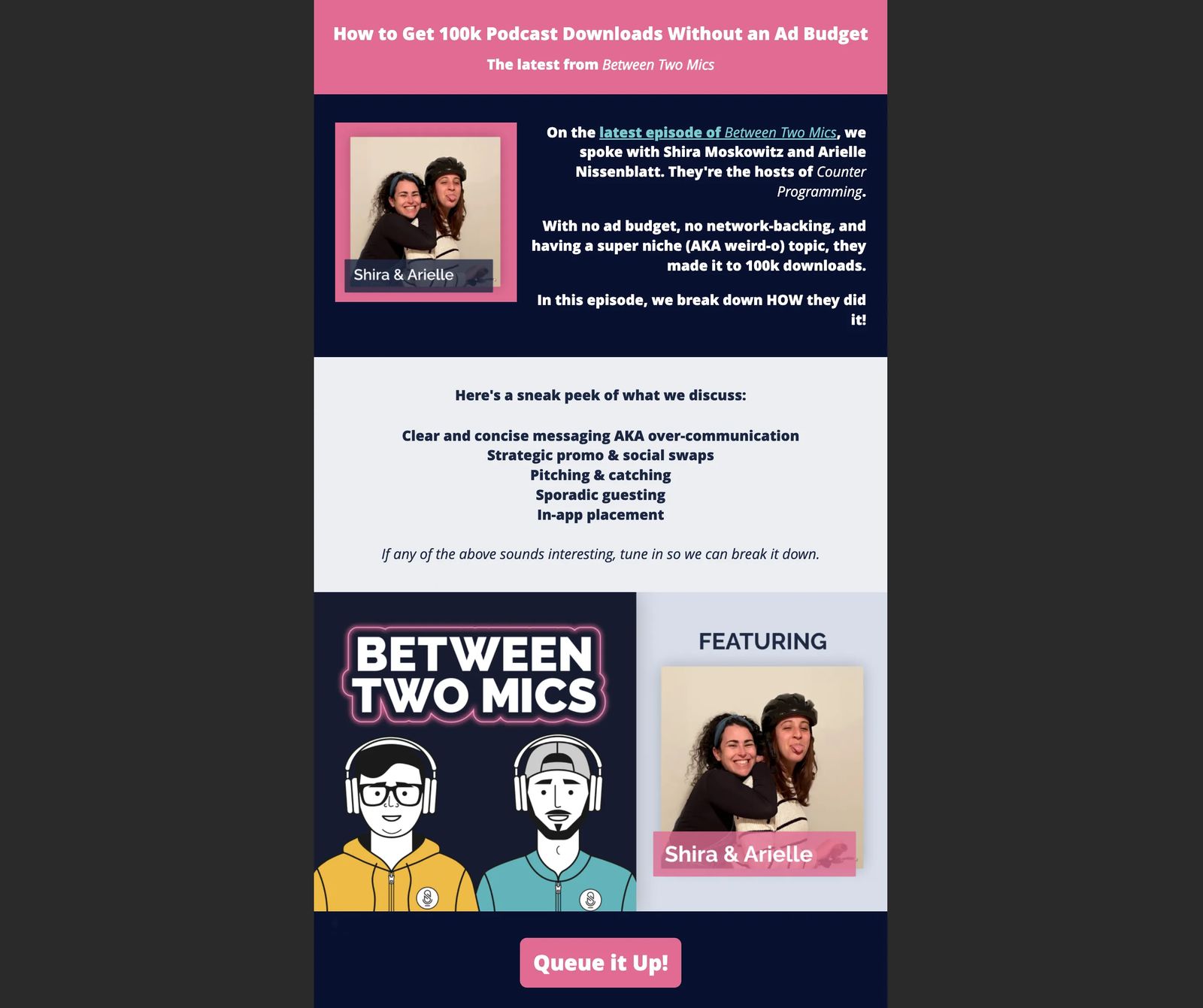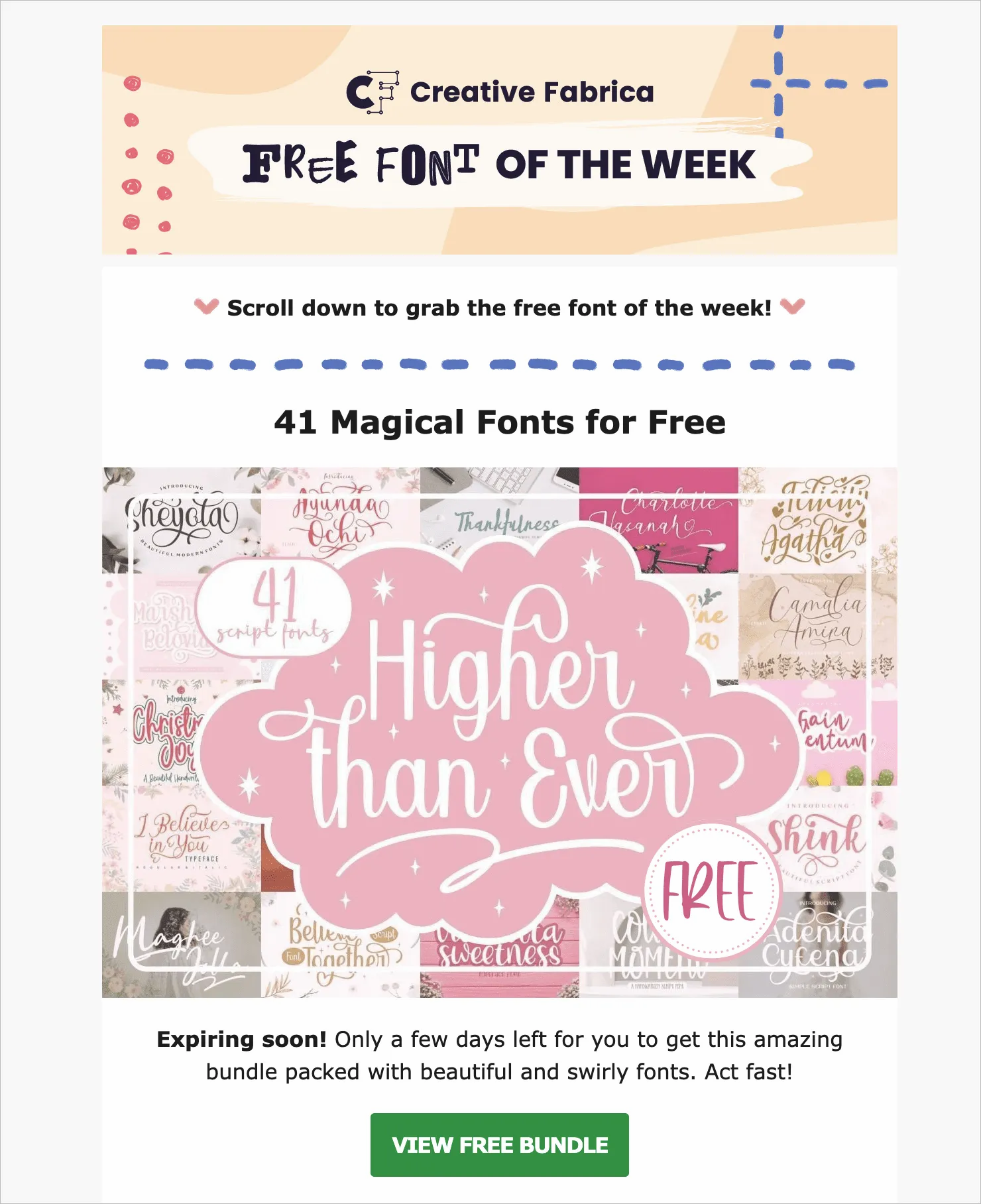
Create an email marketing strategy–11 steps for beginners
Jessica Baldwin / Published July 6, 2022
Ready to learn how email marketing can help generate sales for your business?
Email marketing is effective for many different types of businesses. It will help you establish an audience, engage with your target market, build trust, and increase sales. Whether you're selling a product, service, or information, it can help you reach your goals.
Most people need to see or hear from your brand several times before they'll take action. Email helps your business stay in front of potential customers until they are ready to buy from you.
It's an affordable way to attract your ideal customer and build long-term relationships.
But email isn't only about reaching prospects. It can also help foster affinity, usage, and repeat purchases with existing customers.
What is email marketing?
Email marketing is the practice of using email as a channel to build relationships with current and potential customers while promoting information, products, and services.
Organizations send email campaigns to distribute information and promotional offers to subscribers. The end goal is to generate revenue.
Can your business benefit from email marketing?
Yes! Organizations, large and small, and across all industries, can use email to connect with their audience and grow revenue.
How effective is email marketing?
For every one dollar spent on email marketing, businesses generate a return of around $45. Worldwide, email marketers report a median return on investment (ROI) of 124%, according to 2017 data from Statista. Compare that with a reported 30% ROI for social media marketing, and it's clear investing in email marketing is worthwhile.
Marketers use email because it's an affordable way to drive results. You may need to spend some money on advertising to grow your list, but once you have someone's contact information, the cost of reaching them again drops.
How to start an email marketing strategy
Creating an effective email marketing strategy requires careful consideration of the recipients and your business objectives.
1) Choose an email marketing platform
To send marketing emails, you'll need an email marketing platform. Email service providers enable you to:
- manage your subscriber list
- design and send marketing emails
- automate the subscribe/unsubscribe functions
- track open and clickthrough rates
- and more
Mailchimp, ConvertKit, Constant Contact, Campaign Monitor, Flodesk, and Active Campaign are some of the most popular email marketing tools. Many offer generous free plans, so getting started is easy and affordable.
2) Define your ideal customer
As with all marketing activities, you need to understand your audience. Developing an ideal customer persona (if you haven't done so already) will help you create content, messaging, and incentives that resonate with your desired audience.
3) Establish an opt-in incentive
Why should someone provide your business with their email address? Your potential subscribers will ask themselves, "what's in this for me?" You'll need to answer that question to persuade them to enter their email.
Will they receive a discount? Are you going to provide helpful tips or information that will make their lives better? Will they be entertained?
The opt-in incentive is different for each business. It should be determined based on the needs of your target audience and aligned with your business objectives.
4) Develop a lead magnet
Once you establish an opt-in incentive, develop a lead magnet for your target audience. A lead magnet is something you provide to your audience for free in exchange for contact information. It can be an info product like a special report, helpful guide, workbook, exclusive video, podcast episode, free course, and more. It may also be a free product trial, a discount offer, or a free item or service.
Your email content may generate sign-ups on its own; this is especially true for content creators, online publishers, and bloggers. The newsletter content is so valuable for readers; they sign up just for the information.
5) Grow your list
Once you've defined your incentive and created a lead magnet for it, focus on growing your subscriber list.
Add a landing page to your website describing your lead magnet and subscriber benefits. Tell readers what type of content you'll send them once they sign up and how it will help them.
Generate traffic to the landing page through social media, online ads, partnerships, and more. Learn how to grow your email list.
6) Develop your email content strategy
To execute an effective email marketing strategy, you must have a content plan. Sending emails on a whim or only when you have a promotion to share isn't an optimal approach to email marketing.
Take the time to develop a consistent and considerate strategy. Place your ideal customer's needs at the center of your plans. Then, define how you'll achieve your business objectives.
7) Decide on a schedule
How often will you send content to your audience? The "right" frequency is different for every business. Some newsletter publishers will send a daily newsletter, while other organizations send communications weekly. Others may focus on sending less frequent but more in-depth emails every other week. There's no right or wrong schedule. Consider what your ideal customer would prefer and your (or your team's) ability to produce the necessary content volume.
8) Establish theme(s)
Organize your newsletter content within specific themes. Your themes should be:
- relevant and appealing to your audience
- related to what your business is or does in some way
- focused in areas where you have a depth of knowledge share
Most businesses achieve better open rates, clickthroughs, and engagement by producing more value-based, informational, educational, or entertaining content than promotions. A good rule of thumb is to create eighty percent informative content; the remaining twenty percent can be promotional.
However, some businesses (like online retailers) run successful email marketing programs with more promotions, including sales, discounts, new product announcements, and more.
9) Choose an email format
You may create original content for your newsletter or curate content from other sources you know your audience will like. The benefit of creation is that you can drive more traffic to your website and establish your business as an authority on your topics. Curation, by contrast, can brand you or your organization as the source of great content around the web within your industry.
Once you've decided how to produce the content, think about how to format the content within your newsletter. Some newsletters are rich with graphics, while others choose a basic text-based layout for simplicity and better deliverability.
Will you include the full text of the information within the email or simply provide excerpts that link to content on your website?
Let's look at a few examples.
Groove is a customer success platform. Their marketing team writes original content in a text-based format. The content within the email gives the reader helpful information. Then, it allows the recipient to dive deeper into the topic by following a link to a related blog post.

Podcast recording platform, SquadCast sends emails that are rich with graphics, colors, and bold fonts. The graphics make the email eye-catching. It stands out in the inbox.

Others, like the e-commerce brand, The Mason Jar Boutique, prominently display a pop-up on the homepage but allows visitors to exit the pop-up if they wish.
For other companies, these tactics may be too aggressive for their target audience. Motivational speaker Mel Robbins promotes her free 3-part training and workbook, visible after visitors scroll down the homepage.
10) Create a content plan and start writing
Now that you have your themes and format create a list of email campaign subjects. You can use a project management tool like Trello or Notion to organize your ideas. If necessary, organize the campaigns to build upon one another. For example, it may be helpful to send an email that explains a particular concept ahead of another article that requires an understanding of that concept. In essence, you're developing an editorial plan to follow.
Once you have a good outline of your campaigns, you can start writing and adding the content into email templates.
If your topics are timely, like breaking news or what's happening "now," it may be challenging to pre-plan email subjects. For most organizations, however, planning will help to stay on topic and maintain a consistent email schedule.
11) Include calls to action
Each email should have a purpose. What should the reader do once they've read the email? Informational emails may contain links to read more on your website, download a resource, and more. For promotional emails, you may include a call to action link or button to direct the reader to shop or sign up. If you're trying to grow your list through referrals, you can include a call to action asking readers to share the newsletter issue with friends.
In a promotional email, Creative Fabrica includes a prominent call to action button to encourage recipients to get a free download and to get traffic to the website.

Tips for email marketing success
Below are a few best practices to achieve better results. The steps above cover the essentials to starting an effective email marketing strategy. The tips below will help you take your email marketing efforts to the next level.
Set up automated emails
Email automation tools make it easier for small businesses to manage successful email marketing campaigns. Many email platforms allow you to configure automation using "email sequences." You can send everyone the same email campaign upon signing up and then set up different rules to trigger the following email in the sequence. An easy option is to send the following email in your series after seven days of receiving the previous email.
Analyze
Once you've started sending to your email subscribers, look at your analytics regularly. Below are the numbers you'll want to review:
Open rate
The open rate is the percentage of people who opened the email. The open rate can help you understand whether or not your subject lines are getting your audience's attention. Poor open rates may also indicate that your emails are going to spam or Gmail's promotions folder.
Clickthrough rate
The clickthrough rate is the percentage of recipients who clicked on a link within the email. Once your subscribers open emails, are they clicking on the links within your content? If generating traffic to your website is a goal, then clickthrough rates will be important.
Unsubscribe rate
Review the percentage of total recipients who unsubscribe from each email. Do specific email campaigns cause more unsubscribes than others? Are you seeing large numbers of people dropping out of your list(s)?
Conversion rate
The conversion rate is the percentage of people who convert (make a purchase, sign up, etc.) after receiving an email. Are you generating conversions when sending promotional emails?
If not:
- you might be attracting the wrong audience
- your email recipients may not be ready to act yet (they aren't warmed up)
- the offer might not be attractive to your subscribers
- Website analytics–Are your email subscribers visiting your website? As your email list grows, is your website traffic increasing? Are people reading your website content and visiting your sales pages?
Bounce rate
The bounce rate is the percentage of subscribed recipients who did not receive an email. A bounce can happen for several reasons. Misspellings in the submission form, invalid email addresses, spam, and emails that are no longer in use (when people switch jobs), can cause your email to bounce. A high bounce rate may indicate that you aren't attracting quality subscribers.
Optimize
First, defining a strategy and consistently executing your plan is essential. After that, you can make adjustments to improve results.
Subject line
Once someone subscribes to your email newsletter, your next challenge is getting them to open and read the messages. The subject line can have a dramatic impact on email open rates. If your email platform supports A/B testing, you can automatically test two different subject lines on an email. If it does not, segment your list into A and B lists so you can run tests to see which subject lines perform better.
Send times
Test sending your emails on different days and times of the week to see if your numbers improve.
Frequency
How often you send emails to subscribers can affect open rates and unsubscribes. Too many emails and your subscribers may become annoyed. Too few, and they may forget they ever subscribed in the first place. Unfortunately, there's no "one size fits all" approach to frequency. For example, many creators send daily emails. Often, their subscribers expect and read most of them. They advertise the "daily newsletter" on their opt-in pages. Other organizations send on a weekly or monthly schedule. Set expectations early and look at your numbers to determine if you should send more or fewer emails.
Content
Is your content resonating with your readers? Suppose you see a dramatic decline in open rates and increased unsubscribes as you send each email. In that case, your content may not be hitting the mark with subscribers. You may need to improve your writing, the structure of the content, or the general concepts you're presenting. To ensure your emails get delivered (instead of going to spam), limit the amount of promotional language used in your emails. Here's a list of spam trigger words.
Formatting
Formatting can affect the performance of your email campaigns. For some organizations, graphics and design elements can drive more conversions. Others find that text-based emails get higher deliverability and better engagement. You'll only know what works for you by testing different strategies. Check your formatting in various email clients, devices, and browsers to ensure your content displays as intended. Use a responsive design, so mobile users have a good experience.
List segmentation
Get the right message to the right person at the right time. Segmentation helps you send more relevant emails to your recipients. For example, you may not want to send a promotional offer to recently joined subscribers. They aren't warmed up yet and may unsubscribe if you send promotional emails too early. You can segment your list and send promotions to people more likely to convert. You can also send special offers to your most loyal customers.
Technical setup
Improve email deliverability (getting your emails to the recipient's inboxes instead of the spam folder) with a few technical configurations. Send messages from a domain that you own. A dedicated IP address may be a worthwhile investment if you send a high monthly volume of emails. Three other essential pieces to configure for email domain authentication are the SPF Record, DMARC, and DKIM. Carefully review your email provider's documentation on configuring SPF and DKIM records, especially if you use more than one 'sending' service.
Clean your list
Periodically, clean up your list to remove inactive subscribers. If individuals have not opened an email from you in months, they are unlikely to convert. You can run a re-engagement campaign for unengaged subscribers. Ask if they'd like to continue receiving emails and remove those who don't engage or respond.
Include an unsubscribe link in all of your marketing emails. While it's tempting to hide or remove it, the unsubscribe link is required to comply with CAN-SPAM and GDPR. It's also best practice to allow your un-engaged subscribers to opt-out of your list. You don't want to waste email marketing efforts on people who aren't interested in your product, service, or content.
Cleaning your list will help your analytics and ensure you're growing an engaged list of subscribers.
When optimizing, test one adjustment at a time and measure your results. If you try different subject lines and a different send time at once, you won't know which adjustment drove the results.
Request feedback
One of the best ways to create more effective email marketing campaigns is to ask your existing subscribers for feedback. You can add a message to your welcome email asking people to respond. Ask long-time subscribers to rate the content or provide general feedback. Loyal subscribers are often happy to share their perspectives. The information you gather will help you create better content for future campaigns.
When developing an effective email strategy for your business or organization, there's a lot to consider. While the details seem overwhelming, investing in this marketing channel is worth it. Email marketing runs alongside many digital marketers' other strategies like SEO, online ads, and social media marketing to supercharge results.
Email is an effective, affordable way to promote your products, communicate with your audience, and achieve your business goals.
Free workbook: Win customers with your website!
Create a strategy to get more leads and sales from your website.







